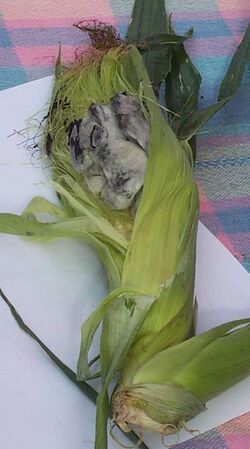Biology:Ustilaginales
| Ustilaginales | |
|---|---|

| |
| Huitlacoche | |
| Scientific classification | |
| Domain: | Eukaryota |
| Kingdom: | Fungi |
| Division: | Basidiomycota |
| Class: | Ustilaginomycetes |
| Subclass: | Ustilaginomycetidae |
| Order: | Ustilaginales (G. Winter 1880)[1] Bauer & Oberwinkler 1997[2] |
| Families | |
|
Anthracoideaceae | |
The Ustilaginales are an order of fungi within the class Ustilaginomycetes. The order contained 8 families, 49 genera, and 851 species in 2008.[3]
In 2011, monotypic family Pericladiaceae Vánky holding just Pericladium Pass. (with 3 species) was added.[4] Also family Cintractiellaceae Vánky was later placed in a monotypic order Cintractiellales McTaggart & R.G. Shivas in 2020.[5]
Ustinaginales is also known and classified as the smut fungi. They are serious plant pathogens, with only the dikaryotic stage being obligately parasitic.
Morphology
Has a thick-walled resting spore (teliospore), known as the "brand" (burn) spore or chlamydospore.
Economic importance
They can infect corn plants (Zea mays) producing tumor-like galls that render the ears unsaleable. This corn smut, is also known as huitlacoche and sold canned for consumption in Latin America.
Sexual reproduction
Almost all Ustilaginales species share a dimorphic life cycle that includes an asexual, saprophitic yeast-like stage and a filamentous sexual stage that is required to parasitize a host.[6] The parasitic phase involves karyogamy, the process of fusing two haploid nuclei (present in haploid teliospore cells), followed by meiosis.[6] Each meiosis results in a septated basidium bearing four haploid basidiospores which can then proceed to yeast-like growth. During meiosis, genes are expressed that function in recombination and DNA repair.[6]
See also
- Huitlacoche
References
- Notes
- ↑ Winter G. (1880) (in German). Rabenhorsts Kryptogamen-Flora von Deutschland, Oesterreich und der Schweitz, Vol. 1. Leipzig: E. Kummer. p. 73. (as "Ustilagineae")
- ↑ Bauer, R. (1997). "Ultrastructural markers and systematics in smut fungi and allied taxa.". Canadian Journal of Botany 75: 1311. doi:10.1139/b97-842.
- ↑ Dictionary of the Fungi (10th ed.). Wallingford: CABI. 2008. pp. 716–17. ISBN 0-85199-826-7. https://archive.org/details/dictionaryfungit00kirk.
- ↑ Vánky, K. (2011). "The genus Pericladium (Ustilaginales). Pericladiaceae fam. nov.". Mycologia Balcanica 8 (2): 147-152.
- ↑ McTaggart, A.R.; Prychid, C.J.; Bruhl, J.J.; Shivas, R.G. (2020). "The PhyloCode applied to Cintractiellales, a new order of smut fungi with unresolved phylogenetic relationships in the Ustilaginomycotina.". Fungal Systematics and Evolution.. doi:10.3114/fuse.2020.06.04.
- ↑ 6.0 6.1 6.2 Steins L, Guerreiro MA, Duhamel M, Liu F, Wang QM, Boekhout T, Begerow D. Comparative genomics of smut fungi suggest the ability of meiosis and mating in asexual species of the genus Pseudozyma (Ustilaginales). BMC Genomics. 2023 Jun 13;24(1):321. doi: 10.1186/s12864-023-09387-1. PMID: 37312063; PMCID: PMC10262431
- Bibliography
- C.J. Alexopolous, Charles W. Mims, M. Blackwell et al., Introductory Mycology, 4th ed. (John Wiley and Sons, Hoboken NJ, 2004) ISBN:0-471-52229-5
Wikidata ☰ Q594740 entry
 |

